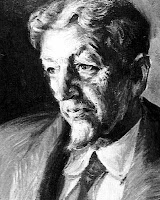
Charles Palache was born in San Francisco, California on July 18, 1869. His father, James Palache, had come to California from New York as a cabin boy in 1849 lured by the gold rush, and there set up as a merchant. His mother, Helen Whitney, had come to California in a covered wagon from Green Bay, Wisconsin. Charles, a sensitive child, showed an early interest in natural history and avidly collected rocks. During his childhood his family moved across the bay to Berkley. In 1887 he graduated from Berkley High School and entered the University of California Berkley, selecting to study mining, because of the emphasis on natural history in the program. He soon found out that he was "repelled by the prospect of life in the mine" but when assigned to make a map of the Berkley hills he found that he enjoyed the work. During the assignment he found a set of ponds up in the hills in a place unlikely for ponds. He returned to the ponds and mapped them with his professor. The lakes were actually a result of the rift that would eventually cause the 1906 San Francisco earthquake.
Palace graduated at the top of his class and stayed at Berkley to earn his doctorate under Andrew C. Lawson. In 1894 Palache went to study in Europe where he studied crystallography under Victor Goldschmidt, laying the foundation for the work he would pursue for the next fifty five years. Palache, after returning to California, received an offer to become an assistant at Harvard University. In 1899 he took part in the Harriman expidition to Alaska, postponing his wedding in order to do so. In 1902 he was named assistant professor, professor in 1910 and professor emeritus after his retirement in 1941.
Palache's major field of work at Harvard was morphological crystallography. There is scarcely a crystallized mineral that he did not work on. He was the first person to bring a Goldschmidt two circle reflecting gonometer to a America. A gonometer is an instrument used to measure the angles of crystals. Palache published over 150 papers on crystallography. In 1919 he helped organize the Mineralogical Society of America and two years later served as its president. He was elected to the National Academy of Science in 1934. In 1936 he was elected president of the Geological Society of America and in 1937 he was the first recipient of the Roebling Medal given by the Mineralogical Society of America. Palache's greatest achievement however was the comp
Plache's greatest achievement, however, was the preparation of the 7th edition of the Dana System of Mineralogy using the new tool of X-ray crystallography. This is the standard handbook used to identify minerals. The first volume was published in 1944 and the second in 1951.
Palache died on December 5, 1954
References:
Daly, Reginald;"Charles Palache: 1896-1954"; Biographical Memiors Vol. 30; National Academy Press; 1957
Frondel, Cliford; "Memorial of Charles Palache" at frankin-sterlilnghill.com
Charles Palache: 1896-1954 at pbs.org

No comments:
Post a Comment